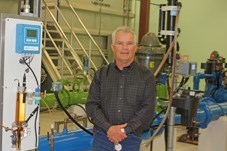Residents are taking it easy on their water use since learning they can now water their lawns and fill their hot tubs.
Town of Turner Valley officials were surprised to see a slight increase in water consumption of only 200 cubic metres per day one week after the Towns of Black Diamond and Turner Valley downgraded their water restrictions from Level 3 to 2 on Aug. 8.
The restrictions were put in place in June of last year when the Black Diamond water treatment plant was destroyed in the 2013 flood and Turner Valley began supplying both communities with water.
“I don’t think demand has climbed as much as I thought it would initially,” said Barry Williamson, Town of Turner Valley chief administrative officer. “People either created some good habits where they care about conserving or they probably realized they save money when they use less water.”
Dennis Leis, Town of Turner Valley utility plant supervisor, said the raw water reservoir that stores the town’s water was measured at 78 per cent capacity as of Aug. 17, compared to 67 per cent when the water restrictions were downgraded a week before.
“Our new water sources are online and everything looks stable,” Leis said. “The water quality is very good. We’re getting maximum capacity out of the new sources.”
A new water well and infiltration gallery constructed this summer began operating last month to help supply both towns with adequate water.
The current water usage is at about 1,800 to 2,000 cubic metres per day, only 200 cubic metres more than the average usage during the Level 3 restrictions, said Leis.
“I think a lot of people are taking this to heart in terms of water restrictions,” he said. “We see spikes on watering days but nothing like what we thought. I don’t think a lot of residents know it’s at a Level 2 water restrictions.”
Leis said the current water use is about 800 cubic metres less than normal consumption when no restrictions are in place.
“If people keep up with this regiment of conserving it won’t take very long to have the raw water reservoir filled, but I do feel they are going to use a little bit more once word gets out,” he said.
In addition to the water restriction change being posted online, a letter was mailed out to residents’ mailboxes on Aug. 15, said Williamson.
He said the double-sided letter informs residents that water restrictions are now at Level 2, which means they can now water their lawns, do outdoor washing and fill hot tubs and pools on specific days and specific times, according to their house number.
Williamson believes the lower restrictions will be a surprise to many residents who are not yet aware the water restrictions have been downgraded, prompting an increase in water usage.
“We’re thinking to some degree once everyone gets that in the mail it might have an impact on demand,” he said.
Williamson said the car washes in both communities are now allowed to operate on town water, and even with those operating the consumption is still low.
He added that having the raw water reservoir at 78 per cent capacity is ahead of what the Town was initially forecasting.
“We wanted it done by the end of October and we could likely achieve that even if there is a bump on demand,” he said.
Williamson said having the raw water reservoir full this fall is critical to ensure the communities have enough water over the winter.
“What it does is it puts us in the position of having enough water to count on over the winter time when, one, we can’t pull it out of the river out of a pit and, two, we are still testing new wells that have been put in place,” he said. “It’s all fairly new and something could fail. If something fails we need to have that reservoir in place.”
Williamson said a full reservoir is just as important in the spring when the water levels increase from runoff and abundant rains, as there could be issues with water quality or potential flood activity.
“The water gets very turbid (in the spring),” he said. “If it gets high enough we tend to shut down the wells and draw from the reservoir, which is very clear and clean.”
Williamson said with the reservoir filling up as well as it is, he hopes it will be at full capacity in just a couple of months.
Williamson and Leis said they appreciate residents’ diligent efforts in conserving water and helping to get the reservoir to full capacity.
“They’ve done a fantastic job of conserving water,” said Leis. “It’s helped us out tremendously.”




